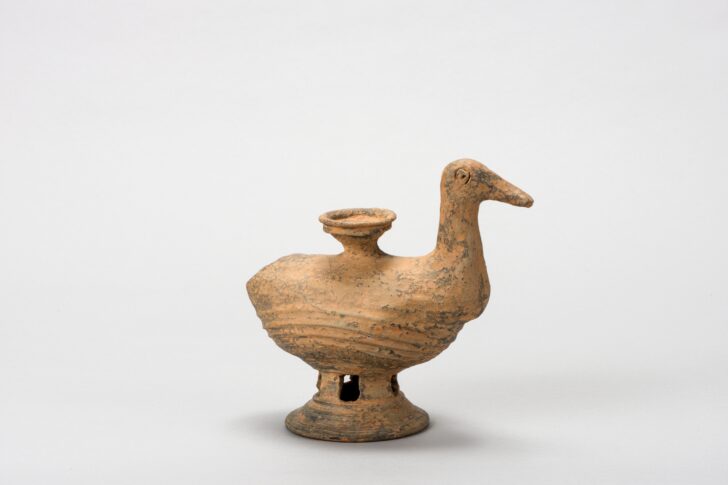Vessel in the shape of a duck
Korean

Description
Duck-shaped vessels are found in both Gaya and Silla as lamps, ewers, and containers. This particular piece was assembled from three wheel-thrown parts—the body, which is a bowl folded nearly in half; the pedestal; and a funnel-shaped cup—and a hand-modeled head and neck. The marks on the body where the potter joined the sections together are clearly visible.
Maribeth Graybill, The Enduring Art of the Korean Potter, December 12, 2004-Dec
Subject Matter:
Ancient Koreans believed birds were the messengers to the spirit world because they can travel over land and water and through the sky. In villages figures of birds can still be seen atop tall wooden poles, recalling their earlier importance. Because they mate for life, even today Koreans especially favor ducks. Many duck-shaped vessels have been discovered in tombs in the ancient regions of Gaya and Silla, suggesting their importance in those ancient cultures (42 - 562)
Physical Description:
A stoneware vessel designed for pouring or possibly to serve as an oil lamp, in the shape of a duck. The lower half of the duck's body and "legs" are formed by a shallow bowl on an openwork pedestal; the sides of the bowl have been compressed to make an elongated shape. The upper half of the duck's body, and its neck and head are formed by hand, The duck's body is hollow, with two aperture: liquids can be poured in through a funnel with a cup-shaped mouth on the duck's back, and liquids can be poured out through a wide opening at the tail.
This is a gray or gray-orange, duck-shaped, low-fired earthenware vessel. Its semi-globular spout is attached to the upper part of the duck’s back, while a 2.8cm wide hole, which appears to have been used for pouring liquids, is located at the tail end. The duck’s beak is flat and wide, and its eyes are expressed by an incised dot and circle. The lower part of the body features three ridges that form a wave design. The pedestal flares out widely and is perforated, in its upper part, by five square apertures.
[Korean Collection, University of Michigan Museum of Art (2017) p. 44]
Usage Rights:
If you are interested in using an image for a publication, please visit https://umma.umich.edu/request-image/ for more information and to fill out the online Image Rights and Reproductions Request Form.